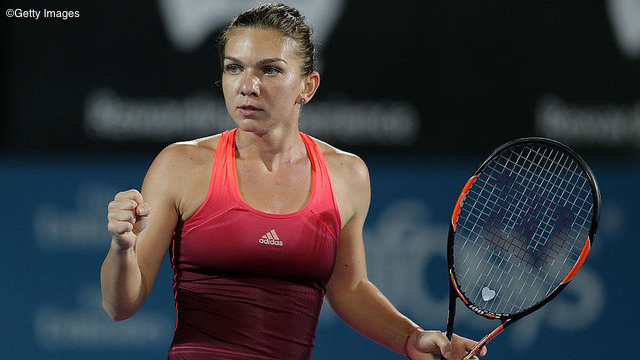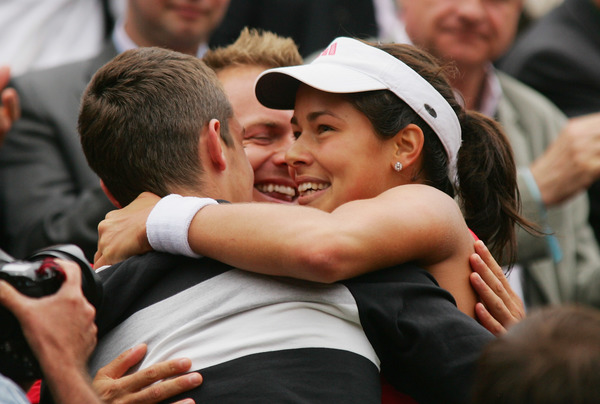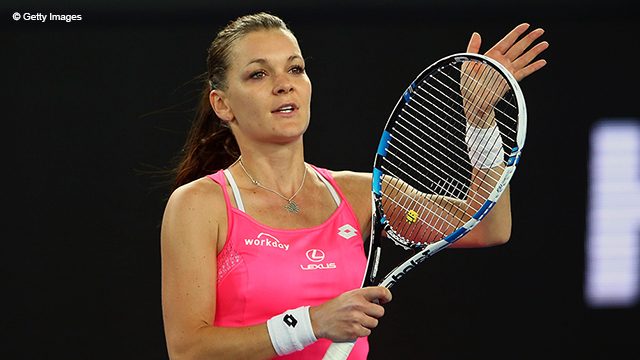Welcome to the Coach’s Corner, a new WTAi series that speaks to the coaches, physios, and fitness trainers tasked with helping turn the WTA players into Grand Slam champions. In this first edition, get to know Scott Byrnes, the man who helped Ana Ivanovic to her maiden major victory, and Eugenie Bouchard to her first major final at the 2014 Wimbledon Championships.
MELBOURNE, Australia – Maria Sharapova, Victoria Azarenka, Ana Ivanovic, and Eugenie Bouchard all have something in common. Each has entrusted Scott Byrnes with her physical training. The 44-year-old Queenslander has become a staple on the tour since he first began as former Australian No.1 Alicia Molik’s traveling trainer in 2001.
Byrnes’ most successful turn came with Ivanovic. Brought onto the team in 2006, Byrnes helped transform Ivanovic into a Slam champion in 2008 at the French Open. He has also worked extensively with Sharapova, Azarenka, Bouchard, and Vera Zvonareva in many of their training blocks in the United States. Now he hopes to do the same for another young hitter in 21-year-old American Madison Keys, with whom he’s worked since the middle of last season.
An entrepreneur and self-described “gypsy”, Byrnes sat down with WTA Insider to discuss his experience as full-time traveling fitness coach, how the physical side of the women’s game has evolved over the years, and his unique methodologies that have made him one of the most sought after trainers in the sport.

WTA Insider: How did you first start in this business?
Byres: I had a personal training business called Complete Fitness in Sydney, Australia. I started training some of the young Australian players out of the gym and then they asked me to travel with them. Back then in 1997 the physical side of things in women’s tennis really wasn’t focused on. It was still in its infancy. There was a niche for having someone working on a player’s fitness.
At that time there wasn’t a lot of physical trainers traveling. Coaches used to do most of the training for the players and I used to look at them and think ‘Oh my god what’s going on here’? It was really old school stuff.
My first private player was Alicia Molik. She was ranked in the 100s at the time and finished with her highest ranking at No.8 in the world. Then it just snowballed from there.
Then there was Ana. She went through a great transformation. I got her at an age when she wasn’t as athletic. We worked hard for 1.5 years before we really had results. She made the final here in 2008 and lost to Maria and then a few months later she won the French Open.
Once you get known in the industry and people see what you’re doing, it gets going from there. Vera Zvonareva for two years, Maria Sharapova for just under a year, Azarenka for just under a year. Then Genie for a year and a half and then I started with Madison.
WTA Insider: That’s quite the resume.
Byrnes: Yeah, it is. I’ve been very fortunate and lucky to work with them. I have a great relationship with all of them. I consider myself privileged.
WTA Insider: Why is it important for players to have a traveling full-time fitness trainer?
Byrnes: What’s important for a trainer traveling with a player is you should have to know the blocks you’re working on. Every session is going to have a different tempo and different loading. So if Madison is in a power block, there’s going to be no slow-twitch repetition. It will all be done in a fast, powerful manner. And the technique has to be correct. So with the trainer being there you’re following the block and he or she can make sure you’re doing it correctly.
There’s also tennis specific exercises which I’ve designed myself since being on the tour since 1997. There’s a lot of tennis specific exercises that are about stability of shot, speed out of the corners and movement. What I do with band work is kind of unique.
What works is that when I work on these exercises with the players they buy into it. It clicks with them and it improves their movement on court. The minute the player sees the work they’re doing off-court pays off on-court, they’re more motivated. Eventually you get a system in place. So you need to have someone who knows what they’re doing and overseeing your fitness on a daily basis.

WTA Insider: Why tennis? How did you become a sport-specific trainer?
Byrnes: I only played recreationally but I liked the sport. It was just a niche at the time. I grew up watching Pat Cash win Wimbledon and I loved Ivan Lendl. So to be on the tour was really special. You get really hooked on it, that whole competitiveness, the build up to big tournaments. When you’re part of the team it’s very special.
WTA Insider: What specific things do you have to be mindful of as a tennis-specific trainer?
Byrnes: With tennis it’s a very specific sport and, I think, one of the hardest sports to do periodization for because the tournaments run throughout the year. You’re trying to peak for specific tournaments but you’re trying to peak for the Grand Slams which are so spread out, or in the case of Wimbledon and the French Open, back-to-back.
It’s almost impossible to have your player peak for those big events. But there are ways you can periodize and have them at 80-90%. So periodization is one of the hardest things and that comes with experience. You have to do a lot of maintenance. The benefits of traveling with your player is if they bomb out of one tournament you can make up for some lost time as well and train. That’s the advantage of having a traveling trainer.

WTA Insider: What specific things do you have to be mindful of when training the women?
Byrnes: With women specifically there has to be a lot of work on the hips. I find there’s a lot of instability with the women in the hips, with female athletes in general. When there’s dysfunction in the hips it can either go up or down the chain. Usually you’ll find problems through the groin area. A lot of the women are pulling their adductor for example.
A lot of the women have an anterior pelvic tilt, which puts pressure on their back as well. There’s too much back extension. So you work on that by building their core muscles, and loosening up the hamstrings and strengthening their posterior chain.
The way you go about training the core has changed. The last year or two years have totally blown out the old crunches and old school exercises that really aren’t helping in a sport specific movement. Especially in tennis, when the hips and racket have to come through together, if there’s a break in the chain the technique breaks down. So a lot of anti-rotation work is required, medicine ball, plank work, as opposed to the old school “six-pack for show” type of work.
WTA Insider: What are the biggest developments on the fitness that you’ve seen from when you first started?
Byrnes: The biggest thing is the way periodization (systematic training to peak for specific competitions by rotating focused training blocks) is coming into the training. You don’t just work endurance-based strength training. People are beginning to understand the power that goes into the sport. Tennis is an anaerobic sport with lots of different interval efforts. So the old school hopping on the treadmill and running may not be appropriate.
Also pre-hab. The trainer really needs to work in with the medical side of things. The top players now have their own medical teams. The therapist and the trainer have to work hand in hand so that you’re not loading on dysfunction. Let’s say your pelvis is rocked. If you go into the weight room and do heavy lifting, you’ll make it worse. So the team has to communicate and work together to keep the player healthy.

WTA Insider: Is it difficult for players to be patient when it comes to their fitness? Given the tennis season I would think it takes years to get a player to their optimum fitness level.
Byrnes: It is. Honesty is the best policy. If you take a job and tell them great things are going to happen in the next three months, you’re screwed. That’s not going to happen. Don’t focus on long-term goals. Breaking the goals down to smaller goals is important. That keeps the athlete more motivated.
WTA Insider: The season goes for 10 to 11 months. Where are the actual training blocks when you can really focus on fitness as opposed to tournaments?
Byrnes: The greatest time for me is the actual off-season. That’s where you can really make some gains. The second block is after Wimbledon. You can also get a block after the Australian Open depending on the tournaments they play. Madison won’t be going to the Middle East so we’ll have a block after that.
There’s also a short one after Miami depending on how they do there. That works out well because you’re going from hard court to clay, so you want to work on footwork and movement. It’s good because the gaps usually correspond with the surface changes, except from clay to grass. Then you’re just trying to get them into Wimbledon healthy.
WTA Insider: How difficult is it to get a player physically ready for Wimbledon? When I see them in Birmingham and Eastbourne they’re usually sore in the lower back or quads or glutes from having to behind down lower to hit the balls.
Byrnes: It’s funny because the guys are almost treating the grass court like a hard court. They wear hard court shoes and slide on the grass. The majority of the women don’t have the speed after the shot to get that slide. Because of that if there’s any problems with the surface, lumps of grass or sand, then you’ll slide. You’re trying to get them familiar with the surface so that they feel stable so they can play confidently while also avoiding injury.

WTA Insider: This may be a minor question, but how much training equipment do you have to travel with?
Byrnes: I’ve probably paid off a house when it comes to excess baggage. I carry a small suitcase of equipment. I travel with a 1kg medicine ball so you can do speed work, which is important. One of the most useful tools which is light is the bands. I use them a lot.
But now, compared to 15 years ago, the gyms at the tournaments are much better. There are smaller tournaments where you need to be adaptable and come up with some things. But it’s good for the players. It gives them something different.
WTA Insider: What gives you the most job satisfaction?
Byrnes: Knowing that you’ve prepared the player to the best of your ability. That should be the focus on the whole team, that we’re focusing on the whole process and not the result. That will translate to the player’s confidence as well. Where they know they had a good off-season or training block and a 10-15 shot rally comes up they know they’ve been pushed hard and they can handle it.
When you’re traveling with the player you want them to be happy, that’s the second thing. You need to do the little things to take pressure off them or little things that make them smile. It’s tough, you know? Madison is 21 years old. They’re spending 5-6 days under strenuous labor. You’re traveling with them 24-7 so you need to be able to have that side of your personality to make them smile.

WTA Insider: What’s the most stressful situation for you?
Byrnes: Injuries. It’s inevitable. These women are throwing themselves around the court and there’s not a lot of down time between tournaments. If they go deep one week there’s going to be some niggling thing that could add up to the next week as well. Unfortunately it takes time to heal, but you have a tournament straight after. So you have decide whether to play the tournament or not.
WTA Insider: What was it like being in the support box and watching Ana win the French Open?
Byrnes: That was huge. That’s by far my standout moment in my career because we worked damn hard for it. I know how hard she worked for it and the sacrifices she made to get there. Especially coupled with the fact that we made the final the year before and Justine [Henin] won there. Just being part of a team was just such a great moment.
WTA Insider: How are you with all the travel?
Byrnes: I’m a bit of a gypsy. I’m a bit of a free spirit. I guess it’s my Sagittarius zodiac. I get itchy feet when I’m in one place for too long. I love traveling, I love the whole sporting environment, I like watching other people train. I’m just lucky to be 24-7 around a sport I love. I think if I was stuck in an office I’d go crazy.
All photos courtesy of Getty Images and Scott Byrnes.










